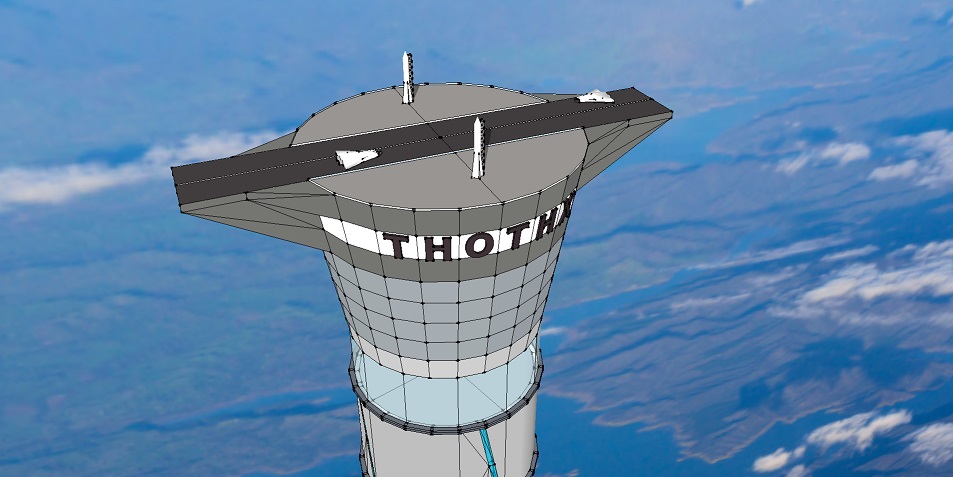In the Limitless episode, "Headquarters!", Brian Finch (Jake McDorman) tracks down the FBI's Ten Most Wanted Fugitives to get his own office. This quest is important to Brian as he sees his role in the FBI as not to only fight crime but the “Enemies of Joy,” and he needs his personal "Headquarters!" to do so. We are talking about some serious business here!
One of the fugitives and Brian's nemisis is Lawrence Drake (Isiah Withlock, Jr.) who happens to be a brilliant engineer and inventor of the inflatable space elevator. Lawrence is also a convicted criminal who was sent to prison for murdering his wife. He subsequently escapes from prison with Lonnie Hyde, a five-time killer, which places him on the Most Wanted List. The problem is that Brian believes Lawrence is innocent.
Like many episodes before, the show manages to get the science right as the space elevator has some basis in fact. The space elevator is space transportation system designed to lift a vehicle, usually along a cable, from the planetary surface into orbit without the need for rockets. There are reasons why this is desirable. It costs NASA more than $10,000 per kilogram to send payload into low Earth orbit, altitudes of about 200-2,000 km. A space elevator will do this cheaper, safer, and more efficiently. So what did the show get right, and what did they get wrong. We separate science fact from fiction.
The Space Elevator from Fiction to Physics

The space elevator idea is not new. First described by Russian rocket scientist, Konstantin Tsiolkovsky, in 1895 in his manuscript, Speculations about Earth and Sky and on Vesta after becoming inspired by the newly constructed Eiffel Tower in Paris. Tsiolkovsky considered a tower that would be built from the ground up to an altitude of 35,790 kilometers (22,239 miles), the height of geostationary orbit. Any objects would attain a horizontal velocity as it rides up the tower, and when released at the top, would have enough speed to remain in orbit at a fixed position in the sky.

The proposed space elevator is a cable attached to the Earth's surface that reaches into space. The counterweight at the opposite end keeps the center of mass above the geostationary orbit point. This produces a centrifugal force that counters gravity and keeps the cable upright and taut.
Tsiolkovsky's proposed tower was a compression structure. As the tower gets taller, the increasing weight on the bottom would eventually cause the structure to buckle under its own weight unless its base was hundreds of kilometers in diameter. Despite the impracticality, it was not until 1959 that another Russian scientist, Yuri N. Artsutanov, suggested a more feasible approach. The tower could be balanced by a counterweight that would extend beyond geosynchronous orbit. The centrifugal force of the spinning Earth on this mass would fling it outwards to provide the tension along the cable to keep the structure upright. Artsutanov also suggested that the cable's thickness should be tapered, being thin on the ground and becoming thickest at geostationary orbit, so that the stress on the cable is constant along its length.
It was not until 1979 that the idea was introduced to the public with the publication of Arthur C. Clarke's novel, The Fountains of Paradise, in which engineers constructed a space elevator on top of a mountain peak in the fictional island country of Taprobane. This space tower uses a fictional hyperfilament with the strength of diamond with almost none of its weight. Clarke consulted with American engineer and space scientist, Jerome Pearson, who published his own concept in 1975, independently of Artsutanov, in the journal Acta Astronautica.
How tall can a space elevator go?
As elegant as the "plum-bob" idea is, it is not without problems. Space elevators are tall and need a material strong enough to withstand the centrifugal forces from the counterweight and support the structure. The simplest way to think about this is in terms of the characteristic or breaking length, or the length a material can be before it snaps under its own weight. We need a material that can reach the necessary lengths to build a space elevator without snapping; steel has a breaking length of about 54 km, while Kevlar, which is just as strong as steel but lighter, has a breaking length of 256 km.
There were no known materials that could reach the lengths needed to build a space elevator, any cable would snap under its own weight before it reached the ground. It was not until the 1985 discovery of bucky-balls by Harold Kroto, James R. Heath, Sean O'Brien, Robert Curl, and Richard Smalley at Rice University that the idea seemed feasible; Kroto, Curl and Smalley were awarded the 1996 Nobel Prize in Chemistry for the discovery of the football-shaped mollecules made up of 60 carbon atoms. Computer simulations showed that these spherical molecules when stretched to create a carbon nanotube, yielded an incredibly strong material. A thread just 1 mm thick had a theoretical breaking length greater than 10,000 km and can hold a mass of 20 tonnes.

Nanotubes can be built in many ways, but chemical vapor deposition (CVD) holds the most promise to create the kilometers long nanotubes needed to build a space elevator. The process starts with a seed metal and carbon atoms are deposited, one atom at a time, to create the tube with the size of the seed determining the thickness of the nanotube. Occasionally, defects along the tube are formed, either from impurities, or the pentagon or heptagon arrangement of carbon atoms occurs where a six-sided hexagon should be. These defects reduce the attractive forces between neighboring atoms and the strength of the tube itself. Radiation from space, either from solar storms or cosmic rays, could rearrange atoms in a carbon nanotube, weakening the thread over time.
As desirable as the material may be, no one quite knows how to make the 100,000 km long thread needed to build a space elevator, and it could be another 50 years before we perfect the technology needed to build one. Carbon nanotubes are microscopic -- a pile of them looks like fine, black soot -- and the longest carbon-nanotube thread made so far is a little over a half-meter long. Growing a thread that long is difficult to control and there are several technical hurdles to overcome before we can produce anything longer.
The Inflatable Space Elevator

If building a space elevator is a so challenging, maybe we can do something simpler: create an aerial platform that makes getting into space easier. This is where Brian's nemesis, Lawrence Drake, comes in! Drake is a brilliant engineer who comes up with the idea for, and patents, an inflatable space elevator with a landing strip at the edge of space. OK, it's technically not at the edge of space but we will get to that in a moment.
There are several thing to note. The idea behind the space elevator depicted in the show is real, and has been patented, not by ST Aerospace, but by a real-life Canadian company, Thoth Technology Inc. Like the space elevator depicted in the show (from Brian's description) the platform extends to a height of 20 km (12 miles). Thoth Technology's space elevator (the real one) is segmented, with each segment made of at least one pressurized cell. The pressure cells are filled with air or another gas, and elevator cars can travel either along the outer surface of the structure or along a shaft along the inside core of the structure. The payload can then be launched from the deck when it reaches to top of the elevator.
On the company's statement page, inventor Brendan Quin, says "Astronauts would ascend to 20 km by electrical elevator. From the top of the tower, space planes will launch in a single stage to orbit, returning to the top of the tower for refueling and reflight." There are reasons for this seemingly crazy idea. In the patent, Quin says that the traditional means of using rockets to reach heights of 50 km and above is inefficient. To put somethings in perspective, Mt. Everest's height is 8.8 km (5.5 mi) above sea-level, and a Boeing 747 can cruise at an altitude of 12.2 km (7.6 mi). Even though an inflatable space elevator is shorter than a "plum-bob" type, it will still be the tallest structure ever constructed.
Reaching Space
Despite the invention's name, and what Brian says on the show, the elevator technically is not a space platform; it is way too short, and neither does not touch the edge of space. Brian can be forgiven, to some degree, as he was not on NZT when he explained the concept to Rebecca Harris (Jennifer Carpenter). The edge of space, or Kármán line, is the boundary between the Earth's atmosphere and outer space where the atmosphere is too thin to support aeronautical flight. Any vehicle would have to travel faster than its orbital speed to generate enough lift to support itself.
The "edge of space" lies about 100 km above ground, and is defined by the Fédération Aéronautique Internationale (FAI), the international body that sets standards and keeps records for aeronautics and astronautics. This means that Thoth Technology's space elevator height of 20 km is nowhere close to the edge of space. While the elevator is significantly below the 35,000 km height necessary to place an object into orbit, there are significant advantages to the raised platform idea. Surface-based rockets must overcome significant air resistance, and waste energy doing so to reach that height. The slower moving, and more energy efficient elevator will experience less drag and save energy. In fact, the goal of Thoth's space elevator is to provide an easier access point for a vehicle to get to space, and not to raise a space vehicle into space.
Ideally, should be raised to the highest possible altitude before launching off a platform, and energy savings are seen once the platform reaches an altitude of 5 km (3.1 mi) and above, something that is well in the range of Toth's space elevator. Of course, whether Thoth's elevator is a space elevator is a matter of semantics. Maybe Brian's description as an "elevator to space" is more appropriate.
Also published on Medium.




